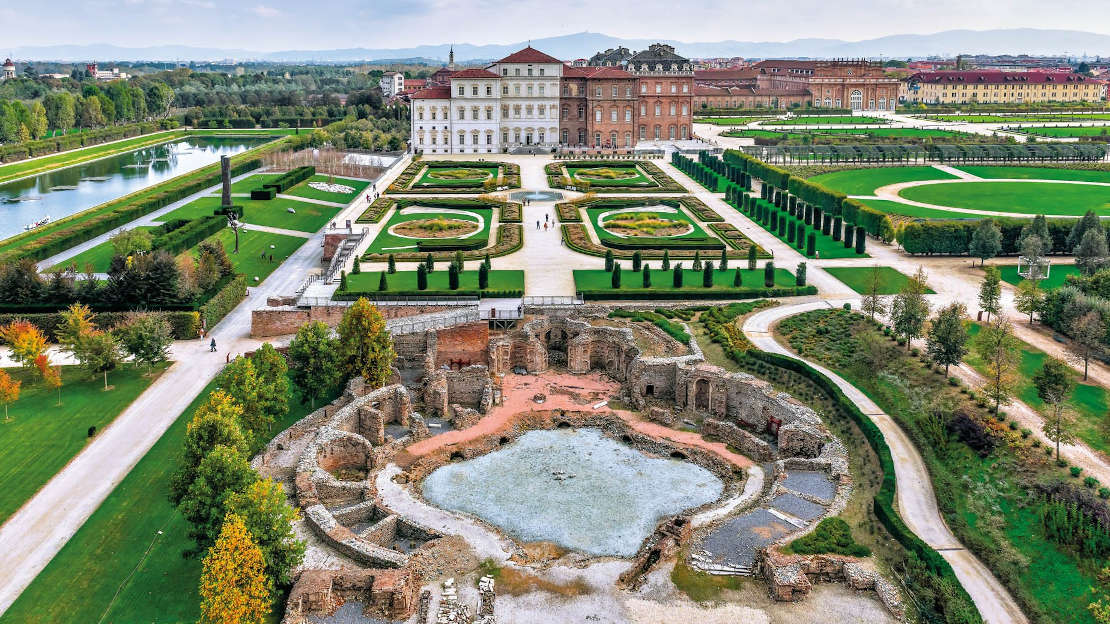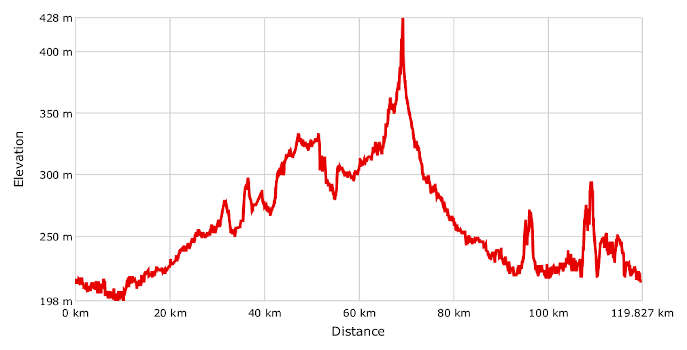
- Bike: trekking/mtb
- Difficulty: ***
- Distance: 120 km
- Altitude difference: 230 m
- Total ascent: 1026 m
- Total descent: 1028 m

The house of Savoy enclosed themselves in a web of royal residences. These were the theatrical backdrop to life at their court, and stand now as majestic proof of the dynasty's power. These magnificent old palaces in town and country were designed by some of the greatest architects of the age. Outside their centre of power in Turin, the family added residences for pleasure and entertainment on the river, in the hills and in the surrounding countryside.
These lavish pleasure palaces of the sixteenth, seventeenth and eighteenth centuries were part of a specific architectural plan, to create a 'ring of delights' around the city.
Today the ring of delights is one of the best-loved cycle routes in Piedmont, for which thanks are due most of all to Bici&Dintorni, the Turin branch of the association FIAB, which got official recognition for the route in 2011 after years of fighting for it.
The route is circular, so you're free to choose where to start and end. We have chosen Borgata Sassi as our starting point, a district of Turin. From here, you can take the funicular railway to the basilica of Superga, where another route in this guide, 'Superga-Albugnano-Crea', begins. The direction of your route is anti-clockwise and takes in all the attractions on the way. Your starting point is on the eastern edge of the city, where the ring of delights follows the cycle path along the Po. A few metres in, you'll come to the first stopping point, Parco del Meisino.
Pedal north from here, passing the industrial estate. Before arriving in Settimo Torinese, you'll find the park by the river, with the smaller Parco della Mezzaluna in its bounds. You can stop here for a picnic in the area with tables and barbecues. You're well out of the built-up area of Turin now. Carry on to Borgaro, where you can admire the castle of Santa Cristina, albeit only from outside, as it is not currently open to the public.
The route carries on to Venaria Reale, a town that absolutely deserves stopping at, passing by the residential area, for the adjoining park of La Mandria, in whose grounds is another of the delights in the ring. The palace of Venaria Reale, known as the reggia, was built for duke Charles Emmanuel II.
Seeing as you're in La Mandria park, you may as well stop at the castle, another of the Savoy residences collectively declared a World Heritage Site by UNESCO in 1997. The fulcrum of the castle buildings is the royal apartments, where Victor Emmanuel II, the first king of Italy, moved in 1863. He brought with him his second wife Rosa Vercellana, known to posterity as la bela Rosin, and their children, Vittoria and Emanuele. Theirs was a morganatic marriage, meaning that she was a commoner and not entitled to his inheritance. The royal apartments in the castle are still fully furnished and host guided tours.
The route goes on through the residential areas of Druento and Pianezza, where you'll come onto the new cycle path on the banks of the river Dora Riparia to Collegno. It's one of the most evocative stretches of the whole route, with a landscape that you wouldn't expect to find on the outskirts of a big city like Turin. Collegno is home to Certosa, which started life as the town's monastery. It was commissioned in 1641 by Christine of France, the Savoy queen, taking the Grande Chartreuse near Grenoble as its model.
You will also find the Provana castle in the town, now used for private weddings and other ceremonies but built by Humbert III of Savoy, the 'Blessed', around 1171.
Once you've passed Grugliasco, going through Parco Porporati and the Leumann workers' village on your way, you'll arrive in Rivoli, the highest point on your route, at 428 m. There is another Savoy residence waiting for you here, the castle, which now holds a museum of contemporary art. After a stop, carry on to Rivalta, whose old castle is worth a visit. The first mention of this fortified building is in an act of donation of 1029, in which Ulric Manfred II ceded it to the abbey of San Giusto in Susa. Once you're back in the saddle, before arriving in Beinasco, you'll go over a futuristic bridge over the river Sangone, and on to Stupinigi, where you could do worse than to visit the splendid Savoy residence, built for hunts and parties built from 1729 to Filippo Juvarra's plans.
Your next stop is at the castle in Moncalieri, one of the oldest of the Savoy residences, perched in its quiet glory atop a hill overlooking the Po. Built for defensive purposes in the Middle Ages, it was expanded and adorned by the house of Savoy to become a 'place of delights'. Much loved by the women of Savoy, among them queen Marie Adélaïde and princesses Clotilde and Letizia, the castle was a place for taking holidays and educating the young princes and princesses, not to mention the backdrop to some sensational stories. Carry on along the river to where it empties into the Po, where the cycle path will take you along the banks of Italy's greatest river to Turin and the Valentino castle, built in the 16th century and successively transformed and expanded at the behest of Christine of France, wife of Victor. It owes its sloping roofs and drains to her French taste.
The next delight is just a stone's throw away, on the right bank of the river Po, the 17th-century Villa della Regina, built for Maurice, prince of Oneglia and passed on to his wife, Ludovica of Savoy. It later became a residence of the Savoy kings.
The last delight in this spectacular ring is the Royal Palace of Turin, centre of the court and of political power and command, and the buildings around it. More than any others, these represent the grandeur of the Savoys. The palace's elegant 17th-century facade and splendid mass of richly furnished rooms reveal the sumptuous court life of the house of Savoy over the centuries. You finish the route at the point you started, in Borgata Sassi, having travelled through time, through the lavish legend of the house of Savoy, one of Europe's oldest and greatest dynasties.
